KALA COTTON カラコットン
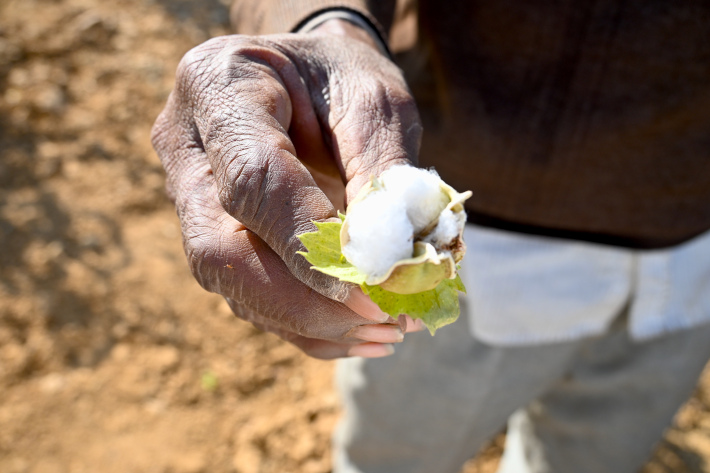
カラコットンとは About Kala Cotton
カラコットンは、グジャラート州カッチ県の東部で栽培されてきた在来種のコットン。現地ではワガド[Wagad]、サカラ[Sakala]などと呼ばれ、地域の暮らしに深く根づいていましたが、 1970年代以降、繊維が長く収量も多い外来種やハイブリッド種への転換が進み、絶滅が危惧されるようになりました。 その後、半乾燥地域でも地中深くに根を伸ばして成育できる、塩分濃度が高い土壌にも強く、天水で育つため灌漑設備を必要としない、病害虫にも強く、農薬や化学肥料を必要としないといった地域の風土に適した特性が見直され、 2007年に、カミール[Khamir]やサトヴィク[Satvik]など複数のNGO、団体が連携し、カラコットンを復活させるための取り組みがはじまりました。
2010-2011年には、このコットンの特徴でもあり、害虫や強風、乾燥などから内側の繊維質を守る黒く厚い殻=kalaにちなむ、カラコットン[Kala Cotton]という名で世に拡められることになりました。
Kala Cotton is an indigenous species that has been cultivated in the Eastern region of Kutch district in Gujarat. Locally it was called Wagad or Sakala and was deeply rooted in their lives. After 1970s, it had been regarded as endangered with the market transition to invasive and hybrid species with longer staples which can expect higher yields. However, the characteristics of Kala Cotton is suitable for the local climate even in semi-arid regions, it grows with roots deep underground. It is resistant to soils with high salt concentrations, a rain-fed crop which does not require irrigation. It is resistant to pests and diseases and does not require pesticides or chemical fertilizers. In 2007 a revival project was started in collaboration with multiple NGOs and organizations such as Khamir and Satvik.
In 2010-2011, it was relaunched as a material product with the name "Kala Cotton". The name Kala comes from the thick black shell of cotton that protects the inner fibers from pests, strong winds and dryness.
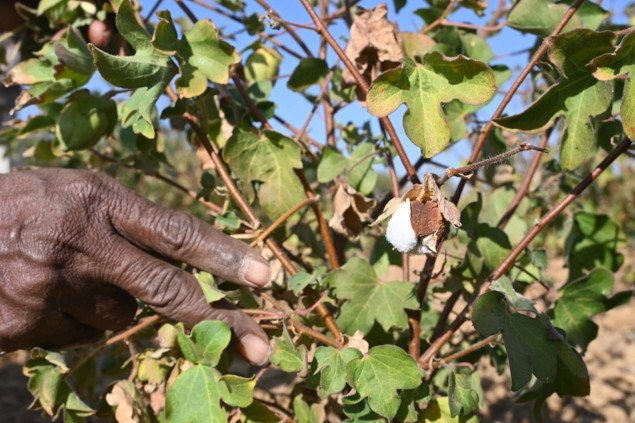
The seeds of indigenous cotton tend to open downwards. Therefore, the shell parts come with puff when they pick, or they just pick both puff and shell together. (Jan 2023)
カラコットンの栽培地域 Cultivation area of Kala Cotton
カラコットンは、かつて、カッチ県を区分する10地区のうち、南西部の海沿いに位置するアブダサ[Abdasa]、マンドヴィ[Mandvi]、ムンドラ[Mundra]、アンジャル[Anjar]、そしてカッチ県の 北部と東部に広がる広大なカッチ大湿原(Rannは現地語で“塩沼”。世界有数の塩砂漠地帯)寄りのラパール[Rapar]、バチャウ[Bhachau]で栽培されていました。現在その栽培は、ラパール、バチャウ地区内の特定の村に留まります。
Among the 10 blocks in Kutch district, Kala Cotton had been cultivated in Abdasa, Mandvi, Mundra and Anjar, which locate along the Southwest coast; also Rapar and Bhachau, which are close to the Great Rannof Kutch (Rann means salt marsh in their local language,It is one of the world's largest salt desert areas) in the Northern and Eastern parts of Kutch. Today it is only cultivated in Rapar and limited villages in Bhachau.
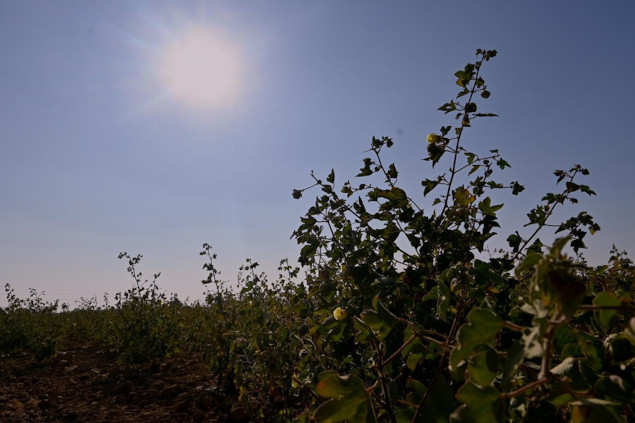
Kala Cotton field in Bhachau. (Jan 2023)
在来種コットンの歴史と現在 History of Kala Cotton and Today
インド亜大陸で在来種として栽培されてきたコットンは、植物学的にはゴシピウム・アレボレウム[Gossypium arboretum]とゴシピウム・ヘルバケウム[Gossypium herbaceum]の2種で、いずれも短繊維種です。 現在世界的に主流の中繊維種のゴシピウム・ヒルスツム[Gossypium hirsutum]に対し、”オールドワールドコットン”やデシコットン[Desi Cotton ](デシはローカルの、土着のという意味)と呼ばれています。 カラコットンは2種類のデシコットンのうち、ヘルバケウムに属するタイプです。
18世紀半ばの産業革命以降、機械紡績に向かない短繊維のコットンは粗野で質的に劣るものとされ、世界の綿産業界では低く位置づけられ、粗布や寝具の中綿などに用途が限定されていました。 また、植民地時代のインドでは、質の向上を目指した外来種の移入が試みられていました。 それでも、透けるように薄いモスリンから独立運動の象徴となった素朴な粗布のカディまで、あらゆる綿布を短繊維種のコットンでつくってきたインドでは、在来種の栽培が根強く続けられており、独立を果たした1947年の時点でも、 国内で栽培されるコットンの97%は在来種(アレボレウムが65%、ヘルバケウムが32%)でした。
ところが独立後、コットンを国の主要産物と位置づけたインド政府は、収量拡大とともに質の向上、つまり長繊維種の開発を目指す農業改革に取り組みます。1970年代以降、多くの産地でヒルスツム系のハイブリッド種への移行が進み、 2000年にその比率が69%となると、アレボレウムは17%、ヘルバケウムは11%に減少しました。さらに2002-2003年にBtコットンと通称されるヒルスツム系の遺伝子組み換えコットン(特定の害虫を駆除する遺伝子が組み込まれている) の栽培が認可されると、インドの綿花農地を席巻し、2014年にはBtコットンが栽培面積の約93%を占めるにいたります。Btコットンは、大幅な収量拡大が見込める一方で、不作時の収入減のリスクが高く、毎年高価な種子を買う必要があったり、 農薬や肥料にも投資が必要になるなど農家への負担も大きく、借金苦から自殺する農家が急増するという大きな社会問題を引き起こしました。
しかし、カッチはインドの他の地域と少し事情が違いました。カッチでも多くの地域でBtコットンへの移行が進んだものの、恒常的に水不足な土地柄で、かつ灌漑設備を整備できない東カッチの一部地域では、 ハイブリッド種への転換が進まず、ヘルバケウム種のワガドコットンが栽培され続けたのです。
しかし、その後、より“上質”なコットンの普及とともに、かろうじて残っていたカッチの在来種コットンでさえその需要を失い、市場価格は下がる一方となりました。多くの農家が、ハイブリッド種や、 コットン以外のより収益性の高い作物への転換をはかり、さらに生産規模も縮小しました。かつては生産する農家から、綿繰り(実綿を繊維と種に分ける)、綿打ち(ゴミを取り除き綿をほぐす)、 糸紡ぎ、織り、染め、そして市場へと現地のコミュニティの間で循環していた地場産業のネットワークも急速に失われていきました。
そうした状況のなか、カッチで有機農業の推進に取り組む生産者団体のサトヴィクが、環境への負荷も農家への負担も少ないワガドコットンに着目します。2007年にはサトヴィクや、 伝統的な手工芸による生計支援に取り組むNGOのカミールなど複数の団体による連携プロジェクト”カラコットン・イニシアティブ[Kala Cotton Initiative]”がスタート。それを皮切りに、 2010-11年のカラコットンのブランド化、2011-12年のオーガニック認証取得へと取り組みが進化していきました。
カミールは、カラコットンをプロモーションするにあたり、かつてワガドコットンによって形成されていた地域の手工芸ネットワークの復活と持続的な雇用創出のしくみを模索しました。 それは職人が糸紡ぎ、織り、染めなどを手掛け、素朴な手織布を作るということでした。カラコットンを守り伝えるということは、そのような生産の生態系を続けるということでもあるのです。
カッチでは2001年の大地震後に急激な工業化が進み、短繊維のコットンを紡ぐ技術も、織る技術も過去のものとなっていました。さらに綿繰りの段階でも、 既存の綿繰業者の長繊維用の機械では処理できない、他のコットンと混ざらないよう専用の機械を必要とするなど、多くの課題がありました。プロジェクトチームは、それらを何年もかけてひとつひとつ解決してきました。
そのおかげでカラコットンは、素材の希少性や環境負荷の少なさ、地域の伝統に根ざした地に足のついたものづくり、そしてなによりその独特な風合いの魅力から、インド国内はもとより海外からも注目を集めるようになりました。
2018年には、それまでの成果をもとにカラコットンの復活を祝う展覧会”サカラトカラ[Sakala to Kala]”がカミール主導で開催され、各地の在来種コットン農家や研究者が参加するデシコットンのセミナーも開催されました。
Cotton cultivated as a native species in the Indian subcontinent is botanically divided into two species: Gossypium Arboreum and Gossypium Herbaceum, both known as short staple species. In contrast to Gossypium Hirsutum, a medium staple species most common globally today, those are called “Old World Cotton”, and in India it is called “Desi Cotton” (Desi means local, native). Kala Cotton belongs to the Helbaceum family which is one of the two varieties of Desi Cotton .
In the late 18th century after the industrial revolution, short staple cotton, which was not suitable for machine spinning, was considered as coarse and of inferior quality. It was evaluated as low grade in the cotton industry internationally, with limited uses such as sackcloth and futon cotton. In fact, every range of cotton fabrics in India, from transparent thin muslin to the simplest khadi cloth which was known as a symbol of the independence movement, had been made with short stapled indigenous cotton.
Therefore, in the British India, they tried to introduce foreign species for better quality though, the cultivation of indigenous species had continued steadily. In 1947, still 97% of the cotton cultivated in India was indigenous species (65% Areboreum and 32% Helbaceum).
However, after the independence, the Indian government positioned cotton as one of major products on the nation and made agricultural reforms aiming expansion of production and quality improvement (in other words, development of long staple varieties). Since the 1970s, with the emergence of Hirsutum hybrid species, many production areas shifted to growing Hirsutum. By 2000, Hirsutum accounted for 69%, while Areboreum had dropped to 17% and Herbaceum to 11%. Furthermore, when the cultivation of Hirsutum-based genetically modified cotton (contains a gene that exterminates specific pests), commonly known as Bt Cotton, had been approved in 2002-2003, it spread across the cotton fields by 2014. Bt Cotton now accounts for approximately 93% of the cultivated area. While Bt Cotton is expected to significantly increase yields, it also became notorious by putting heavy burdens on farmers, which were the high risk of income loss during crop failures as well as annual purchase of expensive seeds, pesticides, and fertilizers. This caused a major social problem, with a rapid increase in the number of farmers committing suicide due to debt hardship.
In Kutch, however, the situation was a little different. Of course, the transition to Bt Cotton has progressed in many areas, however in some areas of East Kutch, where water is constantly scarce and irrigation facilities are not possible to be maintained, Herbacaeum Wagad Cotton has kept preserved.
However, even in Kutch, Wagad cotton has reduced demands with the advent of higher quality cotton, and its market price declined. With no prospects for profits, there was increasing number of farmers who switched to hybrids, or other more profitable crops other than cotton, leading to a shrinkage of production of Wagad Cotton. Along with these changes, the circular chain of process in the local communities, from the farmers, to the cotton ginning (separating cotton into fibers and seeds), cotton beating (removing trash and loosening the cotton), spinning, weaving, dyeing, and finally to the market disappeared. In this situation, Satvik, a producers' organization which promote organic farming in Kutch, has focused on Wagad Cotton,which has been traditionally cultivated in an organic manner and has less risks to the farmers as well as environment.. In 2007, the Kala Cotton Initiative was launched as a collaborative project between Satvik and NGO Khamir, that supports livelihoods through traditional handicrafts. This led to branding of Kala cotton in 2010-11, followed Organic Certification in 2011-12.
Through the process of branding Kala Cotton, Khamir aimed to revitalize the local network of handicraft that Wagad Cotton once connected, also to create a system to sustain the livelihood of the people who were involved. This means developing simple hand-woven fabrics with natural dyeing through the hands of craftsmen at each stage of production, such as spinning, weaving, and dyeing. Promoting Kala Cotton is meant to restore all these process chains.
Kutch experienced rapid industrialization after the earthquake in 2001, and the technology for spinning and weaving short staple cotton became past traditions. Furthermore, there were many challenges in the cotton ginning process, such as that it cannot be processed using existing cotton ginning machinery for long staple cotton, also it requires machinery which is dedicated to the Kala Cotton to avoid mixing with other variety of cotton. Taking many years to solve these problems one by one, Kala Cotton has materialized. Due to the rarity of materials, low environmental impact, sustainable production manufacturing rooted in local tradition, and above all the appeal of its unique texture, it has attracted people's attention not only in India but also overseas.
In 2019, an exhibition called "Sakala to Kala" was held at Khamir to celebrate the revival of Kala cotton based on the achievements made up to that point. A conference meeting was held amongst the farmers and researchers of indigenous cotton from all over the country gathered to promote Desi Cotton.
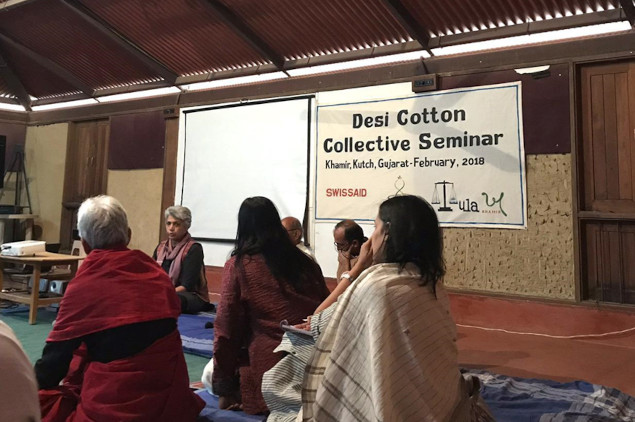
Archana Shah at her talk at Desi Cotton Collective Seminar in Feb 2018. She is a designer and revivalist of craft textiles based in Ahmedabad, also a contributor of photography to Hiroko Iwatate's first book “Gujarat, Rajasthan Desert Village, Life & Crafts“ (Left one among the presenters in the picture).
手がける人びと Craftspersons engage in the process of Kala Cotton
紡ぐ人 Spinners
現在、手紡ぎの主な担い手は、1971年第三次印パ戦争のときにパキスタンのシンド地方からカッチに逃れてきたソーダ・ラージプート[Sodha Rajput]コミュニティの女性たちです。手仕事の技術で名高い彼女たちは、カッチに定住した際、 当時のカディ・アンド・ヴィレッジ・インダストリーズ・コミッション[Khadi & Village Industries Commision]からペティチャルカ(携帯可能なボックスタイプのシングルチャルカ)を配布され、糸紡ぎの技術を習得したものの、 生業として確立するには至らなかったという過去がありました。また、彼女たちは、強い好奇心や向上心があるにも関わらず、他の多くのコミュニティと違って、家の外での仕事に就くことを禁じられています。そのことに注目したカミールが、 ソーダ・ラージプートの村にペティチャルカを試験導入したところ、腕に覚えのある多くの女性たちが興味を示し、競い合って取り組むように。とくに刺繍作業が難しくなった高齢女性には、ちょうどよい代わりの仕事として歓迎されました。 そしてその噂は、ほかのソーダ・ラージプートの村々にも伝わり、取り組みが広がっていきました。
当初、カミールはアンバーチャルカ(手動で複数のスピンドルを回せる効率的なチャルカ)による手紡ぎを推奨しており、効率面からペティチャルカには懐疑的でした。ところが、ペティチャルカ紡ぎを試みたところ、生産効率が低く、 時給換算すると割安になるにもかかわらず、その仕事を好む人も多いことや、その糸を用いた製品に対する市場の反応もよいことがわかりました。それを受けて、2019年末にはアンバーチャルカによる糸紡ぎと遜色のない報酬体系を作り、 ペティチャルカでの手紡ぎも積極的に推進するようになりました。
Currently, the main contributors of hand-spinning are women from the Sodha Rajput community, who fled to Kutch from Pakistan's Sindh region during the Third Indo-Pakistan War (1971).They had been renowned for their handicraft skills, and when they settled in Kutch, they were provided Peti Charkas (portable box-type Single Charkas) by the Khadi and Village Industries Commission promotion organization of the time, and learned the spinning skills. In the past, although they have mastered the craft, they were unable to establish it as a profession. Khamir introduced Petir Charka in the Sodha Rajput village on a trial basis, and many women who knew how to do it showed their interests and started competing their skills. It was especially well received by elderly women who has difficulties to do embroidery work, as a suitable alternative job. As words of mouth spread across Sodha Rajput villages, the project also has been expanded.
Initially, Khamir promoted hand-spinning by Ambar Charka (an efficient charkha that can manually rotate multiple spindles), but had been skeptical about Peti Charka due to its efficiency. However, when they introduced the Peti Charka, they found, many women liked the work despite the fact that the production efficiency was low then the hourly wage was also relatively low. Also they found that the market responded well to the products made from those yarns. Later Khamir has remodeled the remuneration system that is enough comparable to that of yarn spinning by Ambar Charka, and Peti Charka spinning became part of their important value chain.
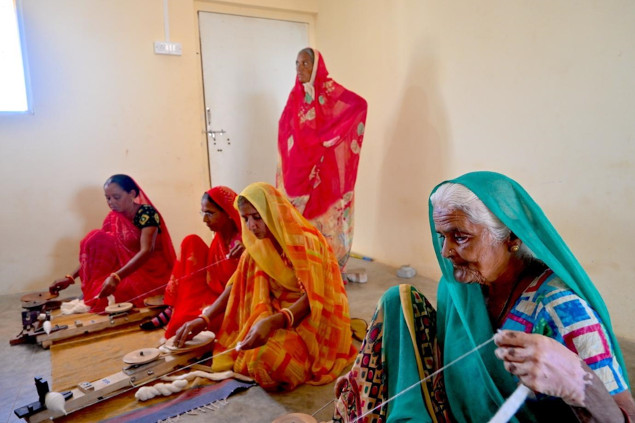
Young Sodha Rajput women are taught by old women who once practiced Peti Charka after migration to Kutch. Jan 2023
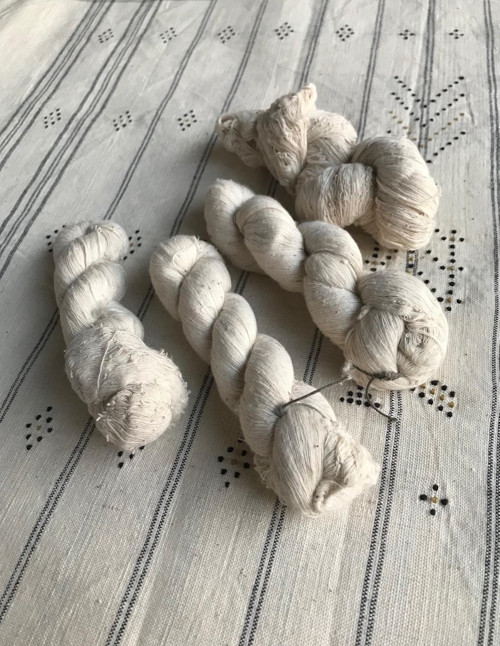
First Petit Charla spined hanks which were shown by Khamir in Aug 2019.
織る人 Weavers
約600年前にラジャスターンからカッチに移り住んだといわれるメーグワール[Meghwal]コミュニティの人びとは、ヴァンカル[Vankar](織り師)と呼ばれ、 代々カッチで織りの仕事を担ってきました。彼らは、牧畜民のラバリ[Rabari]コミュニティが提供する手紡ぎ糸を使って、織りの技術をカッチにもたらしたとされています。 ヴァンカルの織り師コミュニティの移住の経緯については、現地で語り継がれるふたつの物語があります。
ひとつは「ラジャスターンの裕福なラバリ一家の娘がカッチに嫁ぐことになったとき、持参金の一部として花嫁が必要とするあらゆる衣服を織れるように織り師を伴った。 その織り師の家族が発展し、カッチの多くの集落に広がって織り師コミュニティを形成した」というもの。
そしてもうひとつは「ラジャスターンのマルワールからある賢者が巡礼でカッチを訪れた際、何人かの金細工師たちが彼を称えて寺院を建て、その維持のため親族を招くように求めた。 それがきっかけとなってメグワールコミュニティの織り師がカッチに移り住み、その後新たしい村が作られるたびにメグワールコミュニティの織り師家族が招聘される習慣が生まれ、カッチ各地に織り師コミュニティが点在するようになった」というものです。
いずれにしても、ヴァンカルたちは糸の提供者であり顧客でもあるラバリなどの牧畜民たちが飼うヒツジやヤギ、ラクダの毛、そして畑作をするアヒールのワガドコットンを素材として、自ら糸を染め、 織って各コミュニティにアイデンティティを象徴する衣服や布を提供してきました。しかし工業製品が流入し、牧畜民の装束文化が変化するなかで顧客を失い、織りの仕事そのものから離れたり、 機械紡績のメリノウールや化学繊維での織り仕事をはじめたり、伝統的な素材を用いた仕事からは遠のいていくばかりでした。しかしカラコットンの復興を機に、自らカラコットンの糸を調達し、 デザインから生産、流通、販売までを手がけるヴァンカルも登場しました。彼らもまたカラコットン普及推進の一翼を担っています。
The Vankars from Meghwal community, which had migrated to Kutch from Rajasthan about 600 years ago, have traditionally carried out weaving work in Kutch. The Rabari community of pastoralists are credited for bringing the art of weaving to Kutch using hand-spun yarn. There are two stories that have been passed down locally regarding the migration of the weaver community.
First one is when the daughter of a wealthy Rabari family in Rajasthan was to marry into Kutch, she was accompanied by a weaver to produce all the clothes the bride needed as part of her dowry. The family of weavers expanded and spread to many villages of Kutch, forming a community of weavers.
Second one is that when a sage from Meghwal in Rajasthan visited Kutch on a pilgrimage, some goldsmiths built a temple in his honor and asked their relatives to come to help maintain it. This led to the weavers of the Meghwal community moving to Kutch, which led to the custom of inviting weaver families from the Meghwal community whenever a new village was established, and weaver communities were scattered across Kutch.
The Vankars used the wool of sheep, goats, and camels kept by pastoralists such as the Rabari, who had been both suppliers and customers of yarn, as well as Wagad Cotton from the Ahir farmers who had cultivated the fields. They dye and weave their own yarns to provide each community with clothing and fabrics that symbolize their identity. However, with the influx of industrial products and changes in the clothing culture of pastoralists, they lost customers, and more and more people left weaving jobs or shifted to weaving with machine-spun merino wool or synthetic fibers. This led to a decline of works using traditional materials. However, with the revival of Kala Cotton, the Vankars, is now playing a significant role in promotion of Kala Cotton, not only by procuring it but involving in all the business areas such as design, production, distribution as well as sales.
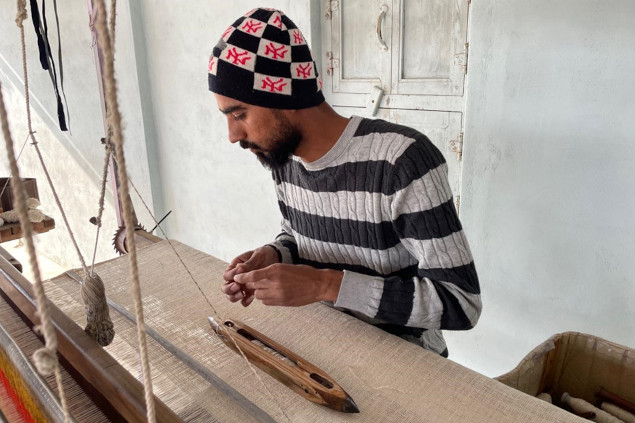
工程 Process
- 種からコットンボールへ From seeds to cotton balls
- コットンボールからスライバーへ From cotton balls to sliver
- スライバーから糸へ From sliver to yarn
- 糸から布へ From thread to cloth
- KALA COTTON INITIATIVE
- Kutch's Wagad or Kala cotton: Back from the (almost) dead/Azera Parveen Rahman
- Reviving a Heritage in Peril : India's Endangered Tradirions of Cotton and Wool/Sushma Iyengar
- Status Paper of Indian Cotton/Directorate of Cotton Development Government of India
- Sandhani, Weaving Transformations in Kachchh/Kalpavriksh and Khamir, with the Vankars of Kachchh
- フィールド調査協力:アブドゥルアジーズ・カトリー(カミール)、カミール他のみなさん、サトヴィク、ジュヒ・パンディ、ヴァンカル・シャムジー・ヴィシュラム、シジュ・ナヴニート・ラムジー
- 資料調査協力:内村航、笠井良子、グエン・チャン・シミン
- 翻訳協力:グエン・チャン・シミン
- 編集協力:笠井良子
- 調査・企画・編集:小林史恵
- Field Research Support: Abdulaziz Khatri (Khamir) and all the Khamir team, Satvik, Juhi Panday, Vankar Shamji Vishram, Siju Navneet Ramji
- Documentation Research Support: Kou Uchimura, Yoshiko Kasai, Gwen Chan Si Min
- Translation Support: Gwen Chan Si Min
- Editting Suport: Yoshiko Kasai
- Research, Planing & Editting: Fumie Kobayashi
カラコットンは8月中旬頃に種を蒔きます。畑は雨が降る直前に耕され、雨水が最大限に浸透するように間隔をあけて穴を掘ります。
播種までに何度も耕し、土壌に水を浸透させます。播種後に数回雨が降れば豊作が期待できるといわれています。雨に恵まれなくても、収穫ができなくなることはありません。収穫高は減るものの、土壌に浸透させた水分の働きと、乾燥に強いカラコットンの特性があるからです。
肥料には、多くの農家が飼っているウシの糞が使われます。11月には最初のワタがはじけはじめ、翌年の4月に苗を撤去するまで2〜3回収穫されます。また農家は畑の半分で綿花、もう半分でムング豆やトウゴマ(ひまし油の原料)を栽培します。 翌年には作物を入れ替える輪作により土壌の活力を高めることで、収穫高を増やそうとしています。
Kala Cotton is sown around mid-August. Fields are plowed just before rain and holes are dug at intervals to maximize rainwater infiltration. Before sowing, the soil is plowed several times to allow water to penetrate into the soil before sowing. It is said that if it rains several times after sowing, a good harvest can be expected. If there is no rain, the yield will be reduced, but with the moisture that permeates into the soil and the characteristics of dry cotton, there still can be harvest. As fertilizer, cow dung is commonly used which are obtainable domestically at farmers own houses.The first cotton plants begin to burst in November and are harvested two or three times until the seedlings are removed in April of the following year. Farmers also divide their fields into two, growing cotton on one side and mung beans and castor beans (the raw material for castor oil) on the other. By rotating crops in the following year, they try to increase the vitality of the soil also can expect higher yields.

3 months after sowing. some cotton balls have already busted, while the others ripen the cotton puffs inside their shells waiting the time has come. Jan 2023
地域の女性グループにより殻から分離されたリントと呼ばれる繊維部分を綿繰工場へ運び、種や繊維に混ざった植物成分を取り除きます。当初は夾雑物が多く残り、布にしたときにチクチクしてしまうという課題がありましたが、 現在では改善されています。取り除かれた葉や殻はウシの飼料となり、種は圧搾して綿実油に、茎は燃料として活用されています。リントは粗紡機で繊維の方向が整えられ、スライバー状に成形されます。
Local women's group segregate the lint, the fiber part, from the shell of cotton ball, and those are transported to a cotton gin where seeds and other plant components mixed with the fiber are removed. In the beginning of project, there was a problem that impurities remaining a lot, which resulted in a prickly texture when it is made into cloth, but now it has been resolved. Those removed leaves and husks are used as feed for cattle, the seeds are pressed into cottonseed oils, and the stalks are used as fuels. The fibers of the lint are oriented using a roving machine and formed into a sliver.

Mountain of Kala Cotton balls, Aug 2019
当初はカミールやヴァンカルを通じ、村の女性たちによるペティチャルカやアンバーチャルカを用いた手紡ぎでの糸作りが目指されていました。しかし、カラコットンそのものの生産プロジェクトが軌道に乗るにつれて、供給が追いつかなくなり、カラコットンの扱いが可能な小規模な紡績工場でも紡績を行うようになりました。 現在では手紡ぎ、機械紡績を併用しつつ、さまざまな太さの糸を作れるようになっています。手紡ぎの場合、ペティチャルカで紡がれた糸は太番手で甘撚りの糸、アンバーチャルカで紡がれた糸は中番手でやや撚りの強い糸になります。
Initially, involving village women through either Khamir or Vankars, they targeted to produce hand-spun yarn using Peti Charka and Ambar Charka. However as the project got on the right track and the supply can not keep up with the demand, gradually small-scale spinning mills which could handle Kala Cotton also started taking their spinning works. . Nowadays, threads with various thickness are available by attaining both hand spinning and machine spinning. In the case of handspinning, the yarn spun with Peti Charka has a thicker count and is lightly twisted, and the yarn spun with Ambar Charka has a medium count and has a slightly stronger twist.
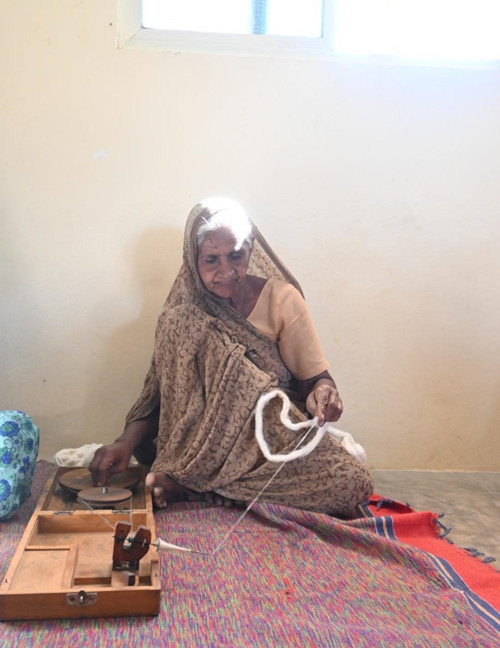
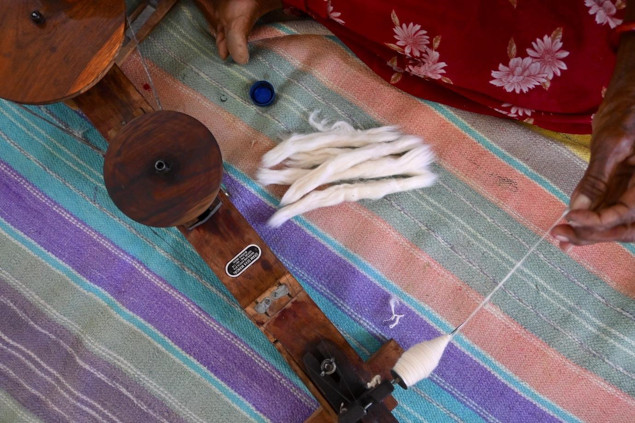
Spinning with Peti Charka. Some women spin with long sliver, while others do with the short one. Jan 2023
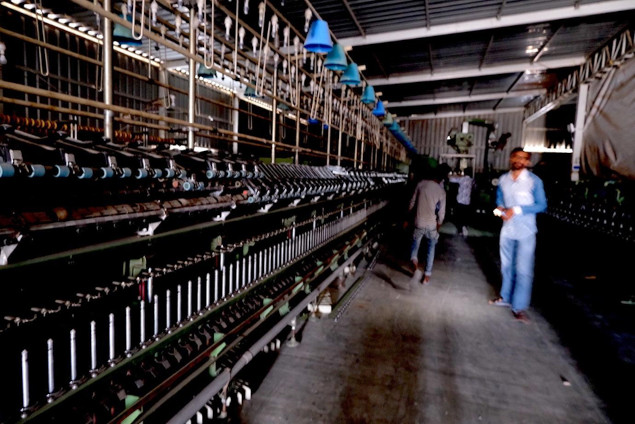
In case of mill spun yarn, it is said that they blend 5-10% of hybrid cotton for stability. Aug 2019
ヴァンカルが、その家族や関係者の協力を得て、経糸や緯糸、機の準備をし、布を織り上げます。紡績糸用とは異なる機の準備や、経糸を補強するための糊付けなど、さまざまな過去の技術の復興が必要でしたが、知識をもつベテランが若い世代の織り師たちにその技術を伝え、若い織り師がそれに取り組むことで実現しました。 ペティチャルカで紡いだ糸からはざっくりした質感の布、アンバーチャルカで紡いだ糸からは独特なシボ感のある布が織られます。
The Vankars weave cloths,having supports from their family members or their business partners in preparing warp and weft yarns as well as looms. For weaving Kala Cotton yarn, it required to revive past techniques, such as loom setting which differed from the one for ordinal mill spun yarn as well as the addition of glue to strengthen the warp threads. There veterans with knowledge overcome the challenges by passing it on to the younger generation of weavers. With yarns spun with Peti Charka, they weave rough textured cloth, while with Ambar Charka one, they make uniquelly clashed cloth.
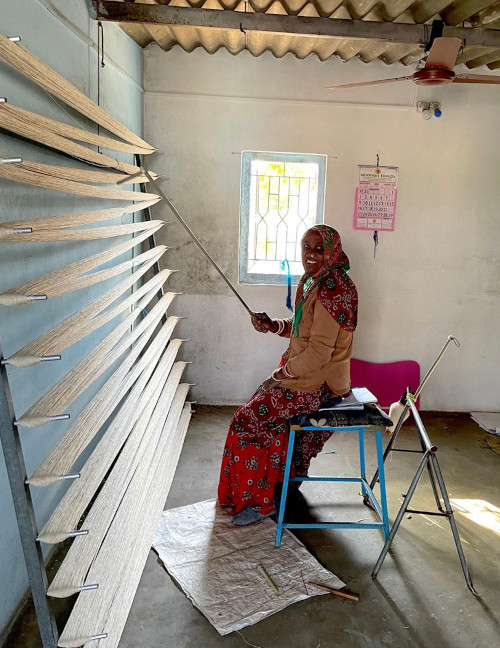
Vankar woman who engaged in warping, Jan 2023
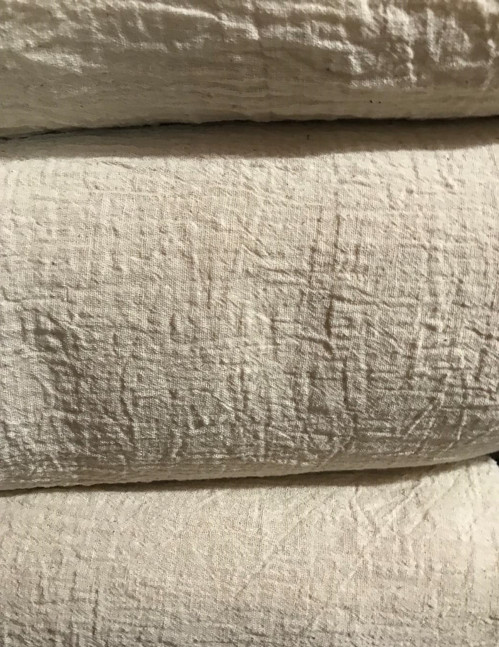
Woven cloths using Ambar Charka yarns, March 2022
参考文献 References
調査編集協力者 Contributor
(敬称略)
